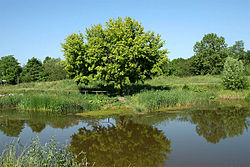Bürstadt
| Bürstadt | ||
|---|---|---|
 |
||
|
||
| Coordinates: 49°38′0″N 8°27′0″E / 49.63333°N 8.45000°ECoordinates: 49°38′0″N 8°27′0″E / 49.63333°N 8.45000°E | ||
| Country | Germany | |
| State | Hesse | |
| Admin. region | Darmstadt | |
| District | Bergstraße | |
| Government | ||
| • Mayor | Barbara Schader (CDU) | |
| Area | ||
| • Total | 34.46 km2 (13.31 sq mi) | |
| Elevation | 90 m (300 ft) | |
| Population (2015-12-31) | ||
| • Total | 16,060 | |
| • Density | 470/km2 (1,200/sq mi) | |
| Time zone | CET/CEST (UTC+1/+2) | |
| Postal codes | 68642 | |
| Dialling codes | 06206, 06245 (Bobstadt) | |
| Vehicle registration | HP | |
| Website | www.buerstadt.de | |
Bürstadt is a town in the Bergstraße district in southern Hesse, Germany, 7 km east of Worms, and 17 km north of Mannheim. In 1981, the town hosted the 21st Hessentag state festival.
Bürstadt lies in the Rhine rift between the Rhine and the Odenwald, and thereby in the Hessisches Ried.
Bürstadt borders in the north on the community of Biblis, in the northeast on the community of Einhausen, in the east on the town of Lorsch, and in the south and west on the town of Lampertheim.
Bürstadt’s Ortsteile are Bobstadt, Bürstadt and Riedrode. Each of the two outlying centres lies roughly one kilometre from Bürstadt.
The name Bürstadt comes from Bisos Stätte (“Biso’s Stead”). Biso was a Frankish prince who had holdings in the area.
Bürstadt lies in one of the most culture- and history-laden of Germany’s old domains. Conditioned by the Rhine rift’s fertile soil and wealth in wildlife and biodiversity, the Rhine’s upper bank was already settled very early on.
A 1.35 m-high monolith that stands in Bürstadt’s municipal area, the so-called Sackstein (49°39′19″N 8°26′4″E / 49.65528°N 8.43444°E), is probably a menhir from the late New Stone Age. Barrows in the Bürstadt woods have yielded some finds that can be dated to Hallstatt times. Also worthy of note are a number of finds from early La Tène times, for example a beaker shaped by hand with finger impressions dating from about 500 BC. Moreover, remains of an extensive Roman settlement can be found on the edge of the Bürstadt woods. For the traveller, Bürstadt, where there was once a Carolingian royal court, lay halfway between the Nibelungenstadt (city connected with the Nibelungenlied) of Worms, founded by Celts, and the former Lorsch Abbey.
...
Wikipedia




